Surgical gowns require extra manufacturing considerations
All surgical gowns are not created equal, and a Nov. 11 presentation at ATA Virtual Expo 2020 helped sort out the differences. The finer points of surgical gowns were discussed by Dr. Martin King, a professor at the Wilson College of Textiles, North Carolina State University, and Jing Liang, president of Medical PPE Consulting LLC.
In the U.S., PPE manufacturing has increased since the COVID-19 pandemic began, says King, and fabric is readily available for gowns. However, the manufacturing process for gowns does require expertise.
King and Liang’s discussion covered the manufacturing basics of surgical and nonsurgical gowns, with an emphasis on classifications, design, materials, standards, testing and regulatory considerations. The gowns are classified by levels one, two, three and four. Only levels three and four are considered surgical. Level three gowns are worn in moderate risk environments, while level four gowns are for high risk procedures like surgery where there are open incisions.
The critical zones of a gown are the front and the sleeves, says King. Some level four gowns have reinforcing film in the front for extra protection. These gowns can be uncomfortable, but a more breathable option has been developed. Fabrics for the gowns include spunlace, SMS non-reinforced, poly film laminate and breathable tri-laminate.
Liang is a manufacturing expert for surgical gowns. She emphasizes that a clean room is required because the gowns must be sterile for use in operating rooms. Because bacteria needs to be minimized in the manufacturing process, validation is required at certain points to ensure that the gowns are sterile when they reach the end users.
Liang discussed the seam types used in surgical gowns. These included stitched seams, ultrasonic welding seams and hot seal seams. Stitched seams can be used in the nonprotective zones of a gown (like the back); ultrasonic seams can be in used in noncritical and nonprotective zones, and hot seal seams are used in critical zones like sleeves. The tie attachment on gowns is especially challenging, because it is important to not compromise the fabric
Registration for ATA Virtual Expo 2020 is open through Nov. 12. All Expo sessions will be posted on the Virtual Expo platform for viewing during Expo and for 30 days after Expo has concluded.










